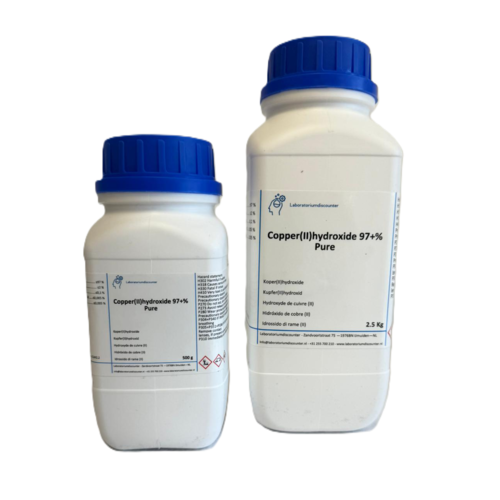Verzending 24–48 u • Levering in de hele EU • Veilige chemieverpakking
Copper(II) Hydroxide 97+% Pure 100g
SKU CUH2.1
€ 15,60
In stock
1
Save this product for later
Copper(II) Hydroxide 97+% Pure 100g
Product Details
CAS number: 20427-59-2
Chemical formulas: Cu(OH)2
Molar mass g/mol: 97,56 g/mol
Density g/cm³: 3,37 g/cm³
UN number: 3288
WGK: 3
EG-Number: 243-815-9
Brand: Laboratoriumdiscounter
What is Copper(II) hydroxide?
Copper(II) hydroxide is an inorganic compound with the chemical formula Cu(OH)₂. It is a blue, crystalline powder that forms when a solution of a copper(II) salt is mixed with an alkaline solution such as sodium hydroxide. This compound is poorly soluble in water and forms a characteristic precipitate in many laboratory reactions.
In nature, copper(II) hydroxide occurs as the mineral spertiniite, but it is almost always produced synthetically for commercial and industrial use. The substance is known for its deep blue color and is often used in demonstrations of chemical reactions or as a raw material for other copper compounds.
Properties of Copper(II) hydroxide
Copper(II) hydroxide is a solid with an intense blue color. It is practically insoluble in water but dissolves in acids, forming copper salts. When heated, copper(II) hydroxide decomposes into copper(II) oxide (CuO) and water. It has a molar mass of 97.56 g/mol and a density of about 3.37 g/cm³. The compound has no clear melting point since it decomposes before melting, typically above 80°C.
Chemical identification of copper(II) hydroxide:
- Chemical formula: Cu(OH)₂
- CAS number: 20427-59-2
- EC number: 243-815-9
Uses and Applications of Copper(II) hydroxide
Copper(II) hydroxide has various applications in agriculture, the chemical industry, education, and electrochemistry.
In agriculture, copper(II) hydroxide is used as a fungicide and bactericide. It is effective against fungal diseases such as mildew and leaf spot diseases in crops like tomatoes, grapes, citrus fruits, and potatoes. It is often an active ingredient in copper-containing crop protection products.
In the chemical industry, copper(II) hydroxide serves as a raw material for producing other copper salts such as copper sulfate and copper chloride. It is also thermally converted into copper(II) oxide, which in turn is used in catalysis, ceramics, and pigment production.
In laboratories, the compound is used for demonstrations, as a reagent in precipitation reactions, and for identifying reducing sugars in combination with Fehling’s or Benedict’s reagent.
In electrochemistry, copper(II) hydroxide has been studied as a possible electrode material for batteries and other applications due to its redox properties.
Safety and Storage
Copper(II) hydroxide must be handled with care. The substance may be harmful if swallowed and causes skin and eye irritation. Additionally, copper(II) hydroxide is very toxic to aquatic life, and release into sewage or surface water must always be avoided.
Protective gloves, safety goggles, and appropriate laboratory clothing should be worn when handling the substance. It should be stored in a tightly closed container in a dry, cool, and well-ventilated place, away from acids and reducing agents.
The substance falls under water hazard class 2 (WGK 2), which means it is considered hazardous to the aquatic environment.
Important hazard statements (H-statements):
- H302: Harmful if swallowed
- H315: Causes skin irritation
- H319: Causes serious eye irritation
- H330: Fatal if inhaled
- H400: Very toxic to aquatic life
Display prices in:EUR

